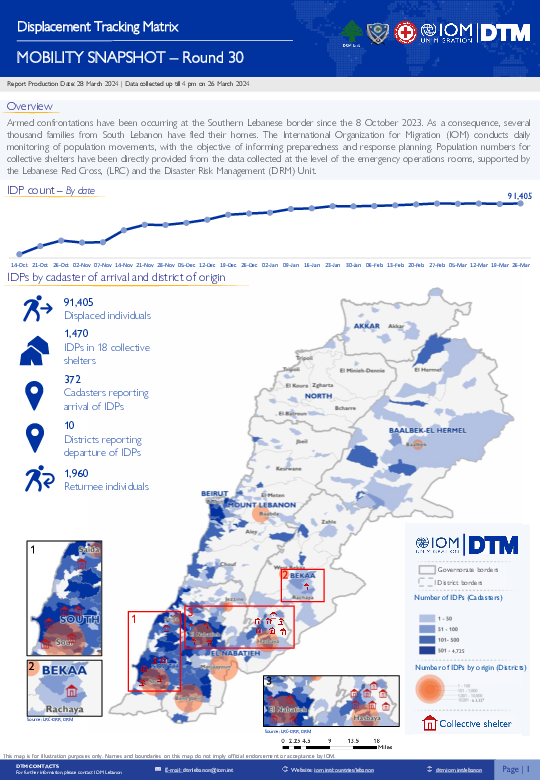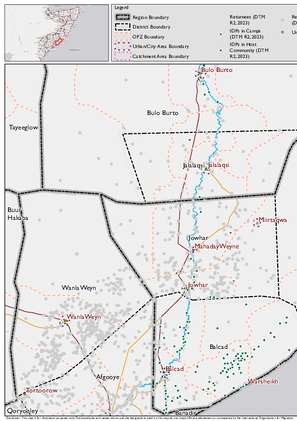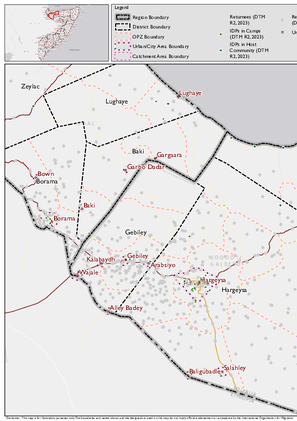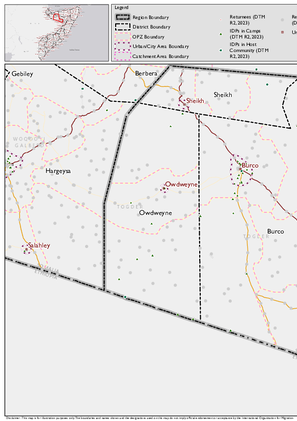-
Countries
-
Data and Analysis
-
Special Focus
-
Crisis Responses
Baseline Assessment

Contact
dtmremapsupport@iom.int mtmtajikistan@iom.int
Language
English
Location
Tajikistan
Period Covered
Sep 13 2023
Nov 11 2023
Activity
- Survey
- Baseline Assessment
The surveys were conducted with return migrant workers using IOM’s Mobility Tracking Matrix (MTM) system in Tajikistan. The survey locations were selected based on the results of IOM’s Baseline Mobility Assessment on returning migrant workers. The report includes findings on socio-economic profile, migration experience, employment and remittances. The survey sample was calculated based on a Baseline Assessment on the presence of returning migrant workers in the selected locations. The interviews were conducted using mobile devices and the KoBo software. All interviews were anonymous, and IOM’s Data Protection Principles were observed throughout the entire data cycle. Data collectors approached potential respondents using the snowball method to obtain their informed consent.

Contact
DTM Sudan, DTMSudan@iom.int
Language
English
Location
Sudan
Period Covered
Feb 22 2024
Mar 21 2024
Activity
- Mobility Tracking
- Baseline Assessment
This report reflects data corresponding to Monthly Displacement Overview 07 dataset, valid as of 21 March 2024. The dataset is available here.
Overview
IOM DTM Sudan presents its seventh Monthly Displacement Overview. This publication provides an account of Sudan’s displacement context since 15 April 2023 – outlining population mobility and displacement, as well as the present and evolving needs of IDPs across Sudan. It provides further contextual analysis for all 18 states for the period between 22 February and 21 March 2024.
Rationale
Recognizing the need for more detailed insights into the IDP situation, including the priority needs, access to services, movement intentions, and demographic breakdowns of the affected population, DTM Sudan has undertaken a comprehensive review of our data collection tool. In collaboration with a wide range of internal and external stakeholders, we have developed a new tool to better inform humanitarian response operations, aligning with the DTM global methodology. Leveraging our extensive network of approximately 367 field-based enumerators and a robust system of over 3,362 key informants across the country, DTM gathered data on IDPs across 7,037 locations, in 181 of Sudan’s 189 localities, across all of Sudan’s 18 states, during March 2024.
Key Findings
- DTM Sudan estimates that 6,552,118 individuals (1,308,617 households) have been recently internally displaced.
- IOM DTM also reports that an estimated 2,019,027 mixed cross-border movements have been made into neighbouring countries.
- Since 15 April 2023, 46 per cent of the IDP caseload sought refuge in the Darfur and Kordofan regions, whereas 53 per cent were observed across the Northern, Eastern, and Central states.
- The majority of the IDP caseload (66%) were seeking shelter with the host community.
- While food remains the highest priority need, health and non-food items are also growing concerns.

Contact
DTM DRC, iomdrcdtm@iom.int
Language
English
Location
Democratic Republic of the Congo
Period Covered
Mar 07 2024
Mar 16 2024
Activity
- Mobility Tracking
- Baseline Assessment
Following the escalation of hostilities between the armed group Mouvement du 23 Mars (M23) and the Congolese Armed Forces (FARDC) and their allies at the end of January 2024, a significant displacement crisis has developed in the eastern region of the Democratic Republic of Congo (DRC), particularly in the North Kivu province. Many individuals and families have been uprooted from their communities, seeking safety and shelter in various areas due to deteriorating security conditions. The intensification of the conflict has forced households to abandon their residences, leading to massive displacements from their places of origin to host communities, established sites, collective centers, and newly created sites. In response to these population movements, especially towards existing or newly established sites, the Displacement Tracking Matrix (DTM) has conducted registrations to keep the data up to date, collect informationon new sites,regularly informstakeholders about the evolutionof movements, and provide data for potential humanitarian assistance.

Contact
dtmlebanon@iom.int
Language
English
Location
Lebanon
Period Covered
Oct 10 2023
Mar 26 2024
Activity
- Mobility Tracking
- Baseline Assessment
Since October 8 there has been an increase in cross-border incidents between Israel and Lebanon, resulting in the displacement of people both within the South and elsewhere within the country. Since October 10, the Displacement Tracking Matrix (DTM) has been conducting the daily monitoring of population movements. The objective of the exercise is to inform preparedness and response planning.

Contact
DTM Papua New Guinea, iompngmdac@iom.int
Language
English
Location
Papua New Guinea
Period Covered
Mar 01 2024
Mar 20 2024
Activity
- Mobility Tracking
- Baseline Assessment
Enga province in Papua New Guinea continues to grapple with heightened tensions stemming from recurring tribal conflicts. These conflicts have led to extensive damage to various essential infrastructure, including shelters, schools, churches, and healthcare facilities, particularly in the Middle Lai area of the Wapenamanda district. Reports indicate significant casualties and mass displacement of populations due to the ongoing fighting. Security forces, comprising both police and military personnel, are actively engaged in monitoring the situation and conducting awareness campaigns within local communities to mitigate tensions and prevent further violence.
Efforts are being made to prioritize civilian safety and prevent the escalation of hostilities. Tribal conflicts often arise from issues such as land disputes, competition over resources, and inter-clan rivalries. The data collected from 25 wards across three Local Level Government (LLGs) in the Wapenamanda and Wabag districts of Enga Province provides insight into the demographic impact of the recent conflict. Wapenamanda district emerged as the most affected area, hosting the largest number of IDPs with 2,718 individuals from 546 households displaced by the recent conflict. This represents approximately 50% of the total displaced population. Wabag Rural follows closely, accommodating 40% of the IDPs, totalling 2,186 individuals from 436 households. Wabag Urban also experiences displacement, with 549 individuals from 108 households seeking refuge.

Contact
iomkyrgyzstan@iom.int
Language
English
Location
Kyrgyzstan
Period Covered
Dec 01 2023
Dec 31 2023
Activity
- Survey
- Flow Monitoring Survey
- Mobility Tracking
- Baseline Assessment
The report presents findings from key informant interviews and surveys conducted in Kyrgyzstan using the International Organization for Migration's (IOM) Mobility Tracking Matrix (MTM) system. Adapted from IOM's Global Displacement Tracking Matrix (DTM) methodology, MTM aims to collect and analyze data to understand the mobility, vulnerabilities, and needs of displaced and mobile populations for evidence-based migration management.
The study utilized DTM's Mobility Tracking Baseline Assessment and Survey methods. Key informant interviews, conducted with local representatives knowledgeable about migrant situations and mobility, provided insights into the timing, locations, and reasons for migrant worker returns. Surveys were administered to returning migrant workers, covering socio-economic profiles, migration experiences, employment, remittances, general well-being in Kyrgyzstan, and impacts of imposed sanctions.

Contact
DTM Somalia, IOMSomaliaDTM@iom.int
Language
English
Location
Somalia
Period Covered
Feb 01 2023
Jan 31 2024
Activity
- Survey
- Mobility Tracking
- Baseline Assessment
Baseline 2, an area-based assessment, is the second step of Mobility Tracking implemented at settlement level and aims to quantify presence of population categories.
As of January 2024, DTM Somalia has mapped around 3,539,634 IDPs, 155,710 returnees and 9,052,583 residents across 17 regions and 10,999 assessed locations. IDPs were present in 45 per cent of locations assessed (4,611 locations) and returnees were present in eleven per cent of assessed locations (1,204 locations).
The report offers detailed results for 17 regions. The results include regions of origins, reasons for displacement and accessibility information among others.
Baseline 2, an area-based assessment, is the second step of Mobility Tracking implemented at settlement level and aims to quantify presence of population categories. For the round 2, data collection occurred between February 2023 and January 2024.
Baseline 2, an area-based assessment, is the second step of Mobility Tracking implemented at settlement level and aims to quantify presence of population categories. For the round 2, data collection occurred between February 2023 and January 2024.
Baseline 2, an area-based assessment, is the second step of Mobility Tracking implemented at settlement level and aims to quantify presence of population categories. For the round 2, data collection occurred between February 2023 and January 2024.
Pagination
- Previous page
- Page 35
- Next page



